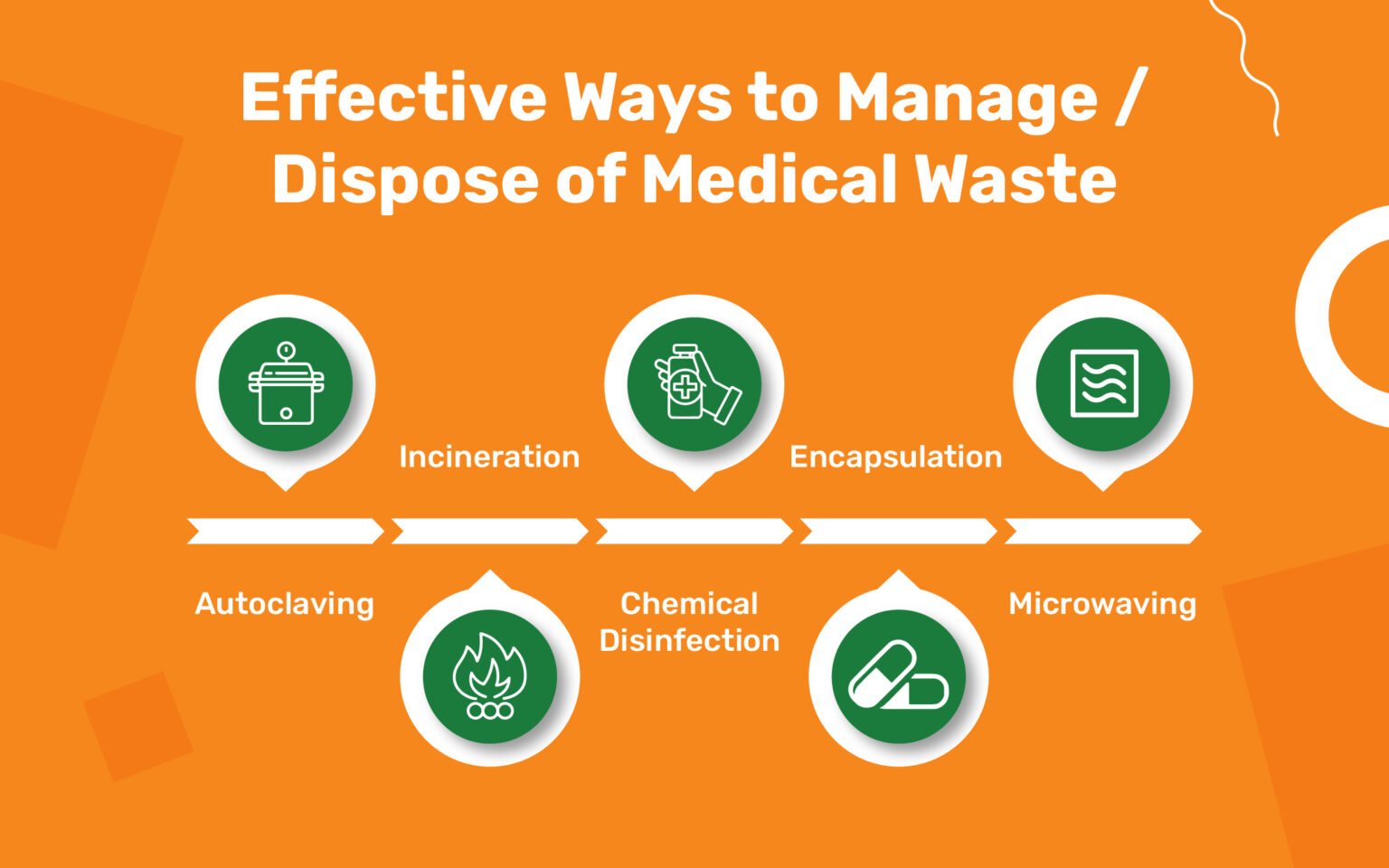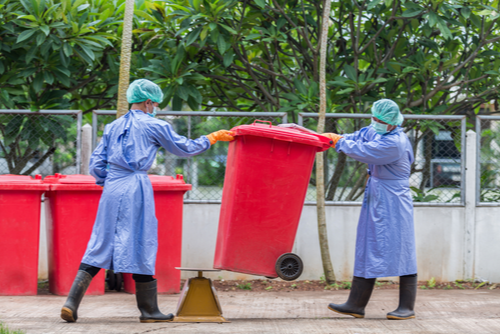Minimize Prices and Optimize Safety And Security: Effective Medical Garbage Disposal Methods
Reliable clinical waste disposal techniques are crucial for medical care facilities to take full advantage of and decrease expenses safety and security. With the expanding concern for ecological sustainability and the increasing number of guidelines surrounding waste monitoring, it is critical for medical care companies to adopt efficient and compliant practices. By implementing appropriate partition and classification, efficient product packaging and labeling, safe transport and handling, reliable treatment and disposal techniques, and compliance with governing standards, healthcare centers can make sure the risk-free and responsible monitoring of medical waste. In this discussion, we will certainly explore each of these approaches carefully, providing understandings and practical pointers for health care specialists to enhance their garbage disposal processes.

Proper Partition and Classification
Proper segregation and categorization are critical components of effective medical waste disposal methods, making certain the safety of healthcare workers, the public, and the atmosphere - medical waste removal. medical waste disposal services with WasteX. By separating different kinds of clinical waste at the point of generation, healthcare centers can lessen the danger of cross-contamination and potential injury to ecosystems and people
One of the essential consider appropriate segregation is the recognition and classification of clinical waste. This includes categorizing waste right into different teams, such as contagious, hazardous, contaminated, or pharmaceutical waste. Each category calls for particular handling, storage, and disposal techniques to avoid any kind of unfavorable results on human health and wellness and the environment.
Moreover, proper partition also consists of using color-coded tags and containers to clearly recognize and distinguish the numerous sorts of clinical waste. This aids health care employees and waste management workers to conveniently acknowledge and take care of the waste appropriately. Red containers might be used for contagious waste, while yellow containers might be designated for dangerous waste.
In enhancement to segregation, proper classification additionally involves the appropriate product packaging and control of clinical waste. This guarantees that waste is safely saved and transferred without presenting any kind of risks to individuals or the atmosphere. Utilizing puncture-resistant and leak-proof containers, in addition to effectively securing and labeling them, helps to stop any type of unintended direct exposure or launch of hazardous substances.
Efficient Packaging and Identifying
Effective packaging and labeling play an important duty in making certain the effective and safe disposal of clinical waste. Correct product packaging is essential to prevent leakage, damage, or splilling throughout transport and handling. It assists to reduce the danger of contamination and safeguards health care workers, waste management employees, and the setting from possible dangers.
Clinical waste ought to be packaged in durable and leak-proof containers that are immune to pierce and breakage. These containers should be effectively secured to stop any type of leakage. In addition, the product packaging ought to be able to withstand the problems of transportation, including temperature level variations and rough handling.
Classifying is similarly essential as it provides critical info about the components of the waste and any kind of potential hazards connected with it. The labels need to consist of the name of the healthcare center, the kind of waste, and any special delivery instructions. Standardized and clear labeling ensures that waste administration personnel can conveniently identify and take care of the waste properly.
Reliable packaging and labeling additionally aid in the correct segregation and classification of medical waste. Clear labeling enables simple recognition of different waste streams, such as transmittable waste, sharps, or pharmaceutical waste. This helps in enhancing the disposal process and making sure that the waste is treated or thrown away based on regulative standards.
Safe Transportation and Handling
Making sure the safe transportation and handling of clinical waste is of utmost importance in order to stop any kind of potential health and wellness and ecological risks. Medical waste, such as sharps, infected products, and pharmaceutical waste, should be effectively packaged and handled to reduce the danger of direct exposure to hazardous compounds and virus.
Transporting medical waste needs conformity with rigorous regulations and guidelines set by ecological agencies and local authorities. These policies aim to secure the health and wellness of employees associated with waste management and prevent the launch of hazardous materials into the environment.
To guarantee risk-free transport, clinical waste must be put in puncture-resistant and watertight containers that are appropriately secured and identified. These containers must be protected in such a way that stops spills or breakage during transit (medical waste removal). In addition, it is crucial to use customized lorries outfitted with ideal safety and security functions to carry medical waste. These vehicles look at here should have ample air flow and be created to stop leakage or contamination.
Handling medical waste additionally requires appropriate training and adherence to safety and security protocols. Workers entailed in the handling of clinical waste should use ideal individual protective devices (PPE) such as gloves, masks, and dress to minimize the danger of direct exposure. They must additionally follow strict hygiene methods to stop the spread of infections and ensure the safe disposal of check here waste.
Effective Treatment and Disposal Techniques
Carrying out ideal therapy and disposal approaches is crucial in managing medical waste efficiently and reducing prospective health and wellness and environmental dangers. Medical waste, that includes sharps, contagious materials, chemicals, and pharmaceuticals, can pose significant hazards if not handled and gotten rid of correctly. There are a number of treatment and disposal methods readily available that stick to governing standards and promote safe practices.
One typical technique is incineration, which includes melting the waste at high temperature levels. Incineration works in destroying pathogens and decreasing the quantity of waste, however it can launch unsafe toxins right into the air otherwise properly controlled. Therefore, it is very important to use contemporary burners furnished with discharge control innovations.
Another method is autoclaving, which utilizes vapor and stress to disinfect the waste. Autoclaving is efficient in killing microorganisms and decreasing the volume of waste, yet it calls for cautious tracking and maintenance to ensure correct performance. The sanitized waste can then be securely taken care of in a land fill.
Chemical treatment is another alternative, which entails utilizing disinfectants or various other chemicals to reduce the effects of pathogens. This approach is frequently utilized for liquid waste, such as research laboratory specimens. However, it is vital to utilize appropriate chemicals and adhere to appropriate procedures to make certain efficient therapy and stop environmental contamination.

Conformity With Regulatory Guidelines
Sticking to regulatory standards is important in making certain proper conformity with medical waste disposal techniques. These guidelines are established to safeguard public wellness, prevent ecological contamination, and keep workplace safety and security. Compliance with regulative standards is crucial for health care centers, as non-compliance can cause fines, penalties, and reputational damage.
Regulative guidelines detail the correct handling, storage space, transport, and disposal of clinical waste. These standards medical waste disposal services with WasteX additionally resolve the partition of various waste streams, such as sharps, transmittable waste, and pharmaceutical waste.
To keep conformity, medical care centers must develop detailed waste administration programs that consist of personnel training, routine audits, and ongoing monitoring. It is vital to keep updated with any changes or updates to regulatory standards, as techniques might progress in time. By staying informed and implementing correct methods, health care centers can decrease the potential for governing offenses and secure the health and wellness of their team, individuals, and the surrounding community.
Verdict
In final thought, executing effective clinical waste disposal strategies is critical for making best use of and reducing prices safety and security. Appropriate segregation and classification, efficient product packaging and labeling, safe transport and handling, and effective therapy and disposal methods are essential steps to ensure compliance with regulatory guidelines. medical waste removal near me. By adhering to these approaches, health care centers can protect the atmosphere and public health while likewise reducing monetary worries related to clinical waste management
By executing correct segregation and categorization, reliable packaging and labeling, risk-free transport and handling, reliable treatment and disposal techniques, and conformity with governing guidelines, health care centers can ensure the risk-free and accountable management of clinical waste. Red containers might be made use of for infectious waste, while yellow containers may be assigned for harmful waste.
Clear and standard labeling guarantees that waste administration employees can conveniently identify and handle the waste properly. (medical waste disposal services with WasteX)
Clear labeling allows for very easy recognition of different waste streams, such as infectious waste, sharps, or pharmaceutical waste. These guidelines additionally attend to the segregation of different waste streams, such as sharps, transmittable waste, and pharmaceutical waste.